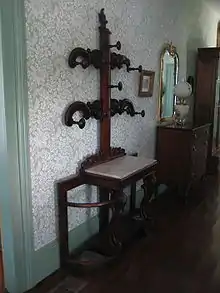Hatstand
A hatstand (UK), hatrack (US) or coat rack is a device used to store hats and often coats on, and umbrellas within. Some upscale catalogues in Europe market it as a portmanteau from the French words Porter (carry) and Manteau (cloak).
| Look up hatstand in Wiktionary, the free dictionary. |

The front hall was the introduction to the house, and as such was an important part of the Victorian home. Furnishings were selected not only to make it a useful place to hang a hat and coat, store an umbrella and leave a calling card, but also to show family wealth, social position and knowledge of current styles. A hall stand or a hatrack was the most important piece of furniture. These were new forms that appeared about 1840, such as the hall tree, as homes became larger and social visits became more structured.
Usually made of wood and standing at least 5 feet (1.5 m) tall, they have a single pole making up most of the height, with a sturdy base to prevent toppling, and an array of lengthy pegs at the top for placement of hats. Smaller houses had smaller front halls, so a hanging hatrack was the answer to the problem of storing visitors' coats and hats. The complicated shapes of the spindles and hooks of both varieties created an interesting pattern on the wall.[1]
By the 1920s, houses had become smaller, and hall furnishings were usually just a chair, a table and perhaps a mirror - a closet or cupboard held hats and coats.